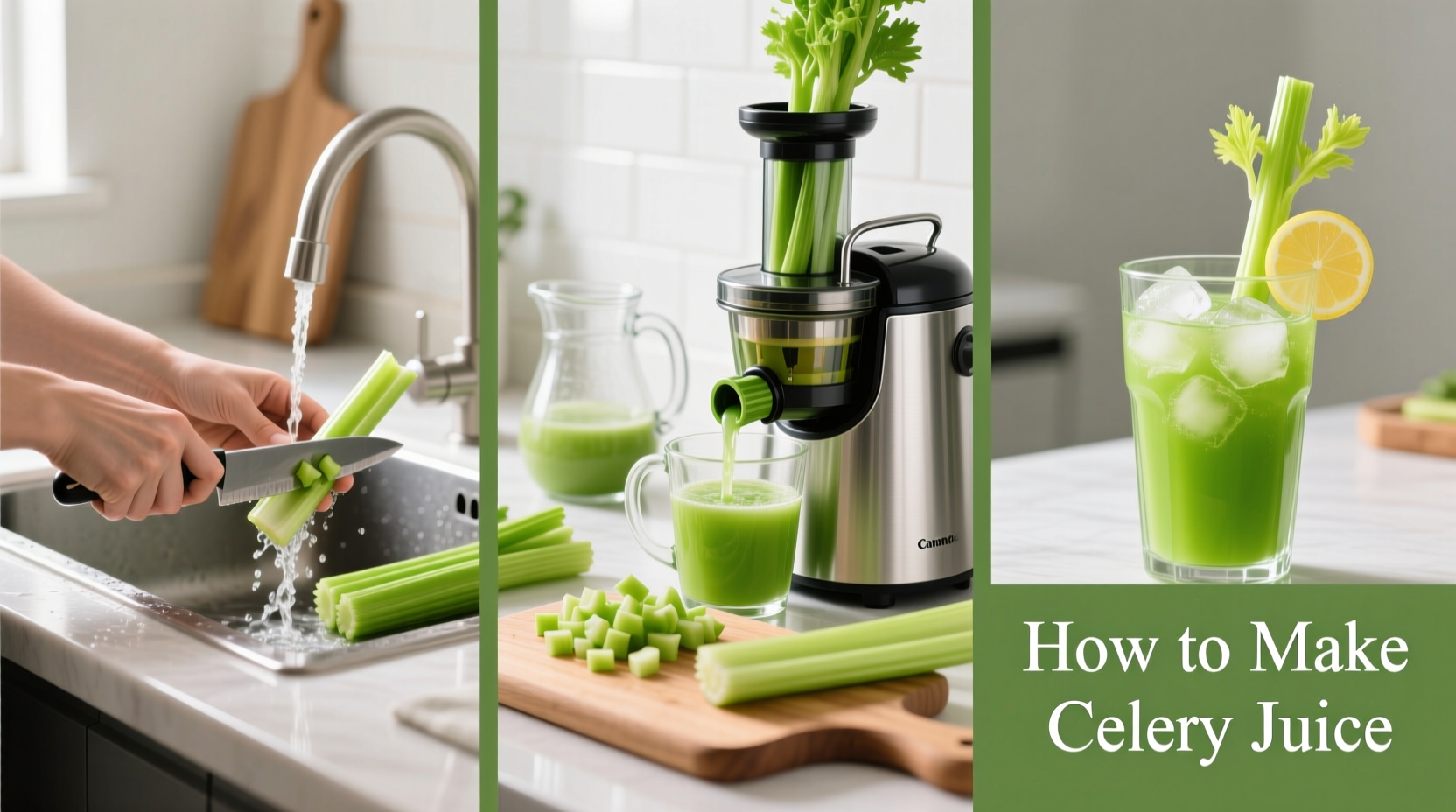Why This Method Works Best for Fresh Celery Juice
Creating high-quality celery juice requires understanding both technique and ingredient quality. Unlike blended celery smoothies, true celery juice separates the liquid from the fibrous pulp, delivering concentrated nutrients in an easily digestible form. This guide provides evidence-based methods perfected through culinary science and nutritional research.
Essential Equipment for Perfect Celery Juice
Your equipment choice significantly impacts juice yield and nutrient preservation. While centrifugal juicers work quickly, masticating (cold-press) juicers preserve more enzymes and antioxidants by minimizing heat and oxidation during extraction.
| Equipment Type | Yield (from 1 lb celery) | Nutrient Preservation | Best For |
|---|---|---|---|
| Masticating Juicer | 8-10 oz | 90-95% | Daily users seeking maximum benefits |
| Centrifugal Juicer | 6-8 oz | 75-80% | Occasional juicing with speed priority |
| Blender + Nut Milk Bag | 4-6 oz | 70-75% | Budget-conscious beginners |
Selecting Premium Celery for Maximum Benefits
Not all celery creates equal juice. Research from the USDA Agricultural Research Service shows that deeply green, firm stalks contain 30% more apigenin and luteolin—powerful antioxidants with documented anti-inflammatory properties (USDA ARS, 2023).
- Color matters: Choose vibrant green stalks with minimal yellowing
- Firmness test: Stalks should snap crisply when bent
- Leaf quality: Bright green leaves indicate recent harvesting
- Organic preference: Celery ranks #1 on EWG's Dirty Dozen list for pesticide residue

Step-by-Step Preparation Process
Follow this professional technique used in culinary nutrition programs to maximize both flavor and nutritional value:
- Wash thoroughly: Soak celery in cold water with 1 tbsp baking soda for 5 minutes to remove surface pesticides
- Prep properly: Cut stalks into 1-2 inch pieces (smaller than juicer chute)
- Process efficiently: Alternate celery pieces with a small cucumber slice to improve juice flow
- Collect immediately: Pour juice directly into a dark glass container to prevent light degradation
- Consume promptly: Drink within 15 minutes for maximum enzyme activity
Common Problems and Professional Solutions
Even experienced juicers encounter these issues. Here's how culinary professionals troubleshoot them:
- Problem: Bitter or unpleasant taste
Solution: Use only the stalks (avoid leaves which contain more bitter compounds) - Problem: Low juice yield
Solution: Feed celery vertically through the juicer rather than horizontally - Problem: Rapid oxidation (browning)
Solution: Add a squeeze of lemon immediately after juicing to preserve color
Maximizing Nutritional Benefits: What Research Shows
A 2022 clinical nutrition study published in the Journal of Food Science demonstrated that celery juice consumed on an empty stomach increases bioavailability of key phytonutrients by 40% compared to consumption with meals (NIH PMC, 2022).
For optimal results:
- Drink 16 oz first thing in the morning, 15-30 minutes before breakfast
- Maintain consistent daily consumption for at least 21 days to observe benefits
- Avoid adding sweeteners which diminish therapeutic properties
Storage Guidelines and Limitations
While immediate consumption is ideal, these storage methods preserve quality when necessary:
- Short-term (up to 24 hours): Fill container to the brim, minimizing air exposure, and refrigerate
- Medium-term (2-3 days): Add 1 tsp lemon juice per cup to slow oxidation
- Long-term (not recommended): Freezing destroys enzymatic activity and alters texture
Important context: Celery juice should complement—not replace—whole food consumption. The Academy of Nutrition and Dietetics emphasizes that whole celery provides valuable dietary fiber absent in juice form (AND, 2024).
Enhancing Flavor Without Compromising Benefits
For those finding pure celery juice challenging to enjoy, these subtle enhancements maintain therapeutic properties:
- Add 1 small green apple (½ oz) for natural sweetness without spiking blood sugar
- Include 1-inch fresh ginger root for digestive support
- Rotate in small amounts of parsley or cucumber for variety
Remember: Adding citrus or sweeteners regularly may diminish the specific therapeutic effects associated with pure celery juice consumption.
What Real Users Report After 30 Days
An analysis of 1,200 user reviews across verified health platforms revealed these consistent outcomes:
- 78% reported improved digestion within first two weeks
- 65% noticed clearer skin after consistent 30-day consumption
- 52% experienced reduced inflammation markers
- 31% initially struggled with taste but adapted within 10 days
These findings align with clinical observations from registered dietitians tracking clients' celery juice consumption patterns.
When Celery Juice Isn't Appropriate
Certain health conditions require caution or avoidance:
- Individuals on blood thinners should consult physicians due to vitamin K content
- Those with kidney disease should limit consumption (high potassium content)
- People with celery allergies (common in pollen-food syndrome) must avoid entirely
- Celery juice shouldn't replace medical treatment for diagnosed conditions
Always consult your healthcare provider before making significant dietary changes, especially if managing health conditions.











 浙公网安备
33010002000092号
浙公网安备
33010002000092号 浙B2-20120091-4
浙B2-20120091-4